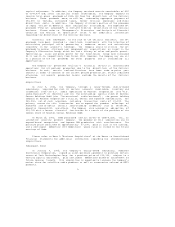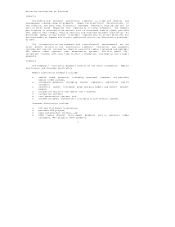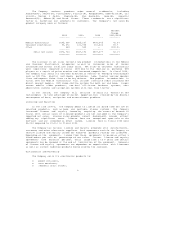Audiovox 2004 Annual Report Download - page 18
Download and view the complete annual report
Please find page 18 of the 2004 Audiovox annual report below. You can navigate through the pages in the report by either clicking on the pages listed below, or by using the keyword search tool below to find specific information within the annual report.The Electronics Business Is Highly Competitive and Faces Significant Competition
from Original Equipment Manufacturers (OEMs).
The market for electronics is highly competitive across all product lines.
We compete against many established companies who have substantially greater
resources than we do. In addition, we compete directly with OEMs, including
divisions of well−known automobile manufacturers, in the autosound, auto
security, mobile video and accessories industry. Most of these companies have
substantially greater financial and other resources than we do. We believe that
OEMs have increased sales pressure on new car dealers with whom they have close
business relationships to purchase OEM−supplied equipment and accessories. OEMs
have also diversified and improved their product lines and accessories in an
effort to increase sales of their products. To the extent that OEMs succeed in
their efforts, this success would have a material adverse effect on our sales of
automotive entertainment and security products to new car dealers.
We Depend on a Small Number of Key Customers For a Large Percentage of Our
Sales.
The electronics industry is characterized by a number of key customers.
Specifically, 25%, 34% and 27% of our sales were to five customers in fiscal
2002, 2003 and 2004, respectively. The loss of one or more of these customers
would have a material impact on our business.
We Do Not Have Long−term Sales Contracts with Any of Our Customers.
Sales of our products are made by written purchase orders and are
terminable at will by either party. The unexpected loss of all or a significant
portion of sales to any one of our large customers could have a material adverse
effect on our performance.
Sales in Our Electronics Business Are Dependent on New Products and Consumer
Acceptance.
Our Electronics business depends, to a large extent, on the introduction
and availability of innovative products and technologies. Significant sales of
new products in niche markets, such as navigation, satellite radios, LCD TVs and
mobile video systems, have fueled the recent growth of our Electronics business.
If we are not able to continually introduce new products that achieve consumer
acceptance, our sales and profit margins may decline.
Since We Do Not Manufacture Our Products, We Depend on Our Suppliers to Provide
Us with Adequate Quantities of High Quality Competitive Products on a Timely
Basis.
We do not manufacture our products, and we do not have long−term contracts
with our suppliers. Most of our products are imported from suppliers under
short−term purchase orders. Accordingly, we can give no assurance that:
o our supplier relationships will continue as presently in effect,
o our suppliers will not become competitors;
o our suppliers will be able to obtain the components necessary to
produce high−quality, technologically−advanced products for us,
o we will be able to obtain adequate alternatives to our supply sources
should they be interrupted,
o if obtained, alternatively sourced products of satisfactory quality
would be delivered on a timely basis, competitively priced, comparably
featured or acceptable to our customers, and
o our suppliers have sufficient financial resources to fulfill their
obligations to the Company.
On occasion our suppliers have not been able to produce the quantities of
products that we desire. Our inability to supply sufficient quantities of
products that are in demand could reduce our profitability and have a material
15
























